Introduction
Last month's Shapella implementation was the most anticipated event for Ethereum and its community since the Merge, mainly due to staked ETH withdrawals from the Beacon Chain being enabled. This event sparked debate about whether it would be bullish or bearish for the ecosystem. Bears argued the unstaked ETH coming into circulation would lead to sustained selling pressure, whereas bulls argued the risk of being unable to withdraw is eliminated, resulting in more deposits.
As a follow-up to the Shanghai Selling Pressure report, in which we covered the landscape of the network before the hard fork, this report aims to provide insights into the current state of the Ethereum network post-Shapella. Specifically, we delve into:
- On-chain data and statistics to better understand the flow of withdrawn ETH to deposits,
- Which entities have withdrawn,
- Where the withdrawn ETH is flowing to,
- Breakdown of the current withdrawal activity and queue,
- Estimating the time it takes to withdraw in current conditions,
- And forecasting the amount of ETH leaving the Beacon Chain on a daily basis.
Overall, this report provides a deeper understanding of the current state of the Ethereum network and helps gauge potential selling pressure as well as the dynamics of ETH flows from investors and entities.
Unstaking Status Breakdown
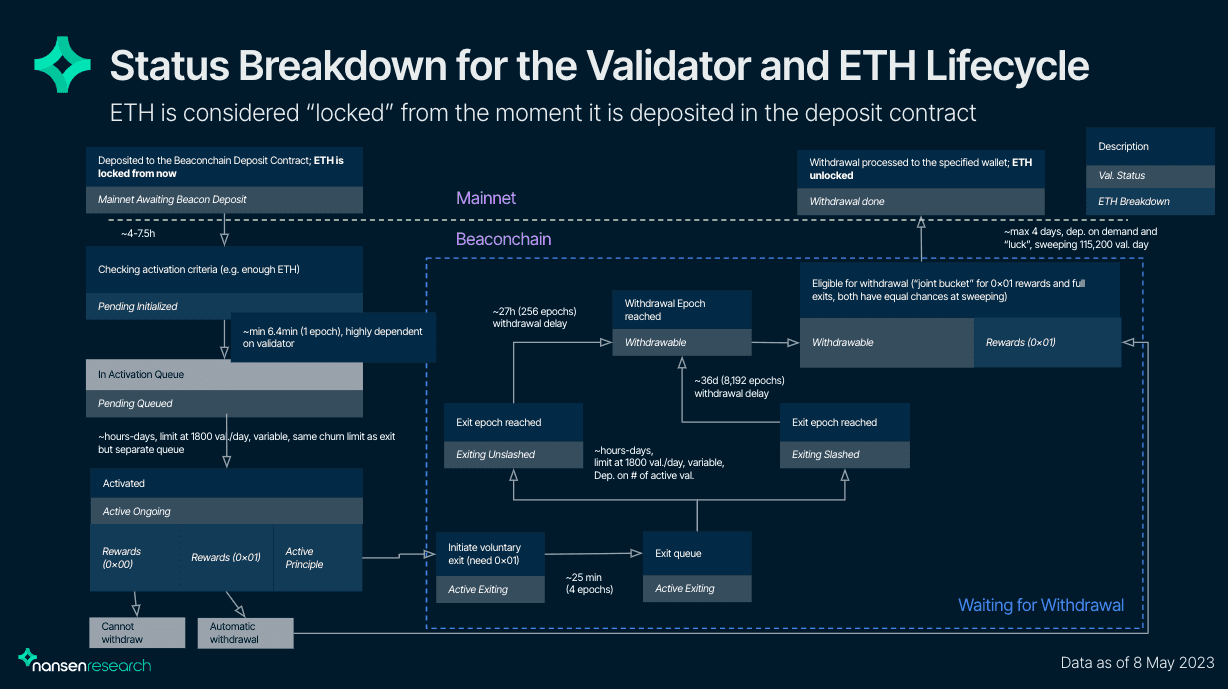
Our definitions are derived from the deposit and withdrawal process as visualized in the chart above:
- Total locked ETH: ETH currently on the Beacon Chain (including rewards and ETH waiting for withdrawal) + ETH that has been deposited to the Beacon Chain Deposit Contract on Mainnet but not yet credited on the Beacon Chain.
- ETH Waiting/Scheduled for Withdrawal: ETH that currently has a withdrawal scheduled. This includes
- Rewards (0x01): All validator balance > 32 ETH of validators that have upgraded to 0x01 withdrawal credentials.
- Active Exiting: All validator balance ≤ 32 ETH of validators that have initiated an exit but are not yet through the exit queue and have reached the exit epoch.
- Exiting Unslashed: All validator balance of unslashed validators that are past the exit queue but still within their 27hr withdrawal delay and not yet withdrawable.
- Exiting Slashed: All validator balance of slashed validators which are past the exit queue but still within their ~36d withdrawal delay and not yet withdrawable.
- Withdrawable: All validator balance of validators that have passed their withdrawal delay (are now withdrawable) and can be included in the sweeping.
- Partial/Rewards Withdrawals: All balance > 32 ETH of full exiters, that have “arrived” on Mainnet.
- Full/Principle Withdrawals: All balance ≤ 32 ETH from full exiters, which have “arrived” on Mainnet.
- Exit Queue: Time from initiating the exit until entering the queue (~25 min) + actual exit queue (variable) + withdrawal delay (27hr).
High-Level Post-Shapella Datapoints
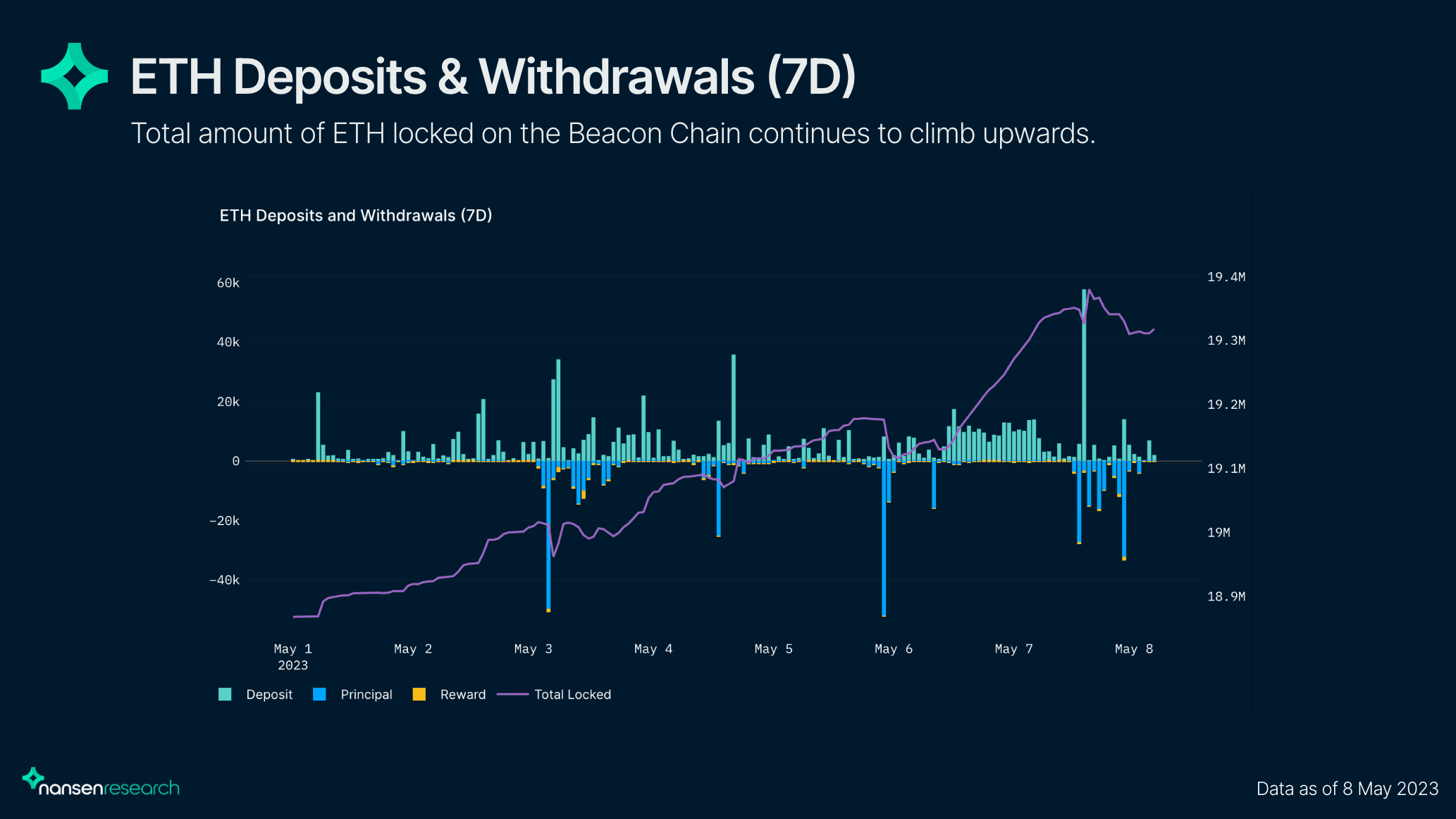
During the time of the upgrade, there were ~19.3m ETH (around 19.1% of the circulating supply) on the Beacon Chain, including rewards. Since then, there has been a total of 2.43m ETH in withdrawals compared to 2.2m in deposits and 102k ETH burned, resulting in a net of ~130k ETH coming into circulation. Including unswept rewards, there is currently 19.3m ETH still staked on the Beacon Chain, meaning Shapella has thus far had a net zero impact on ETH staked.
There are 600k active validators securing the network. Although, approximately 4.5k validators are currently in the exit queue (active exiting), meaning that they are waiting for full withdrawals. With the number of activated validators matching that of exiting validators and the total amount of ETH on the Beacon Chain remaining relatively stable since Shapella, the upgrade has had no net impact on the Ethereum Network.
Breakdown of Withdrawn ETH

For the first two weeks post-Shapella, partial withdrawals made up the majority of all withdrawn ETH. This is because partial withdrawals are processed automatically with every validator sweep (~days), and the validator's only requirement is to provide a withdrawal address. On the other hand, validators who wish to do a full withdrawal must opt out of the network and wait in the exit queue, which could take up to a couple of weeks (which has been the case). Full withdrawals have overtaken partial withdrawals and now represent 59.2% of all withdrawn ETH, compared to 40.8% from partial withdrawals.
Top Withdrawn Entities
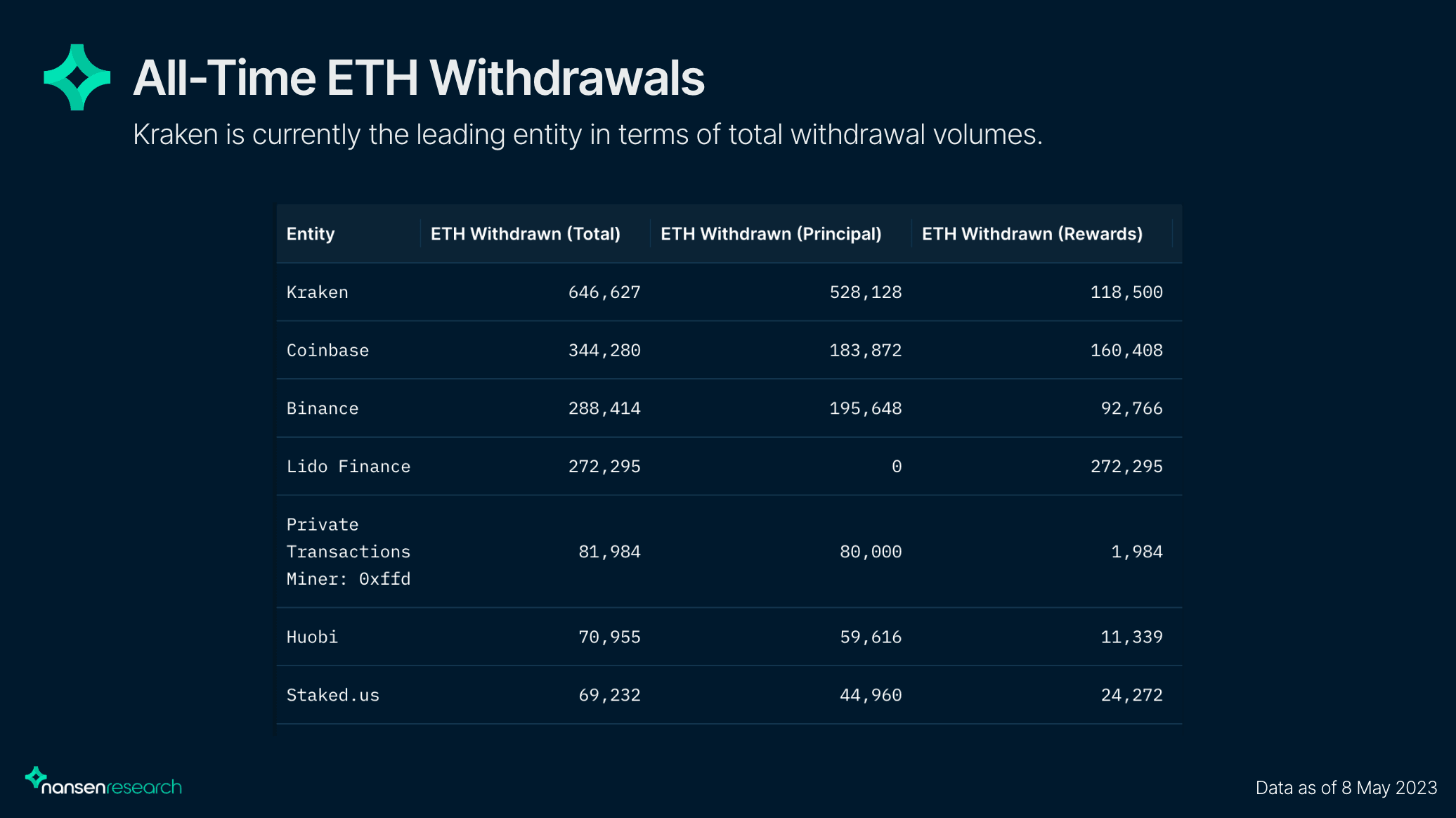
So far, Kraken has been the entity with the most withdrawals at over 647k ETH in total, with principal tokens making up the majority. Kraken's withdrawal volume alone has contributed to approximately 26.3% of all ETH withdrawals since the upgrade. This is due to the recent regulatory crackdown on the exchange's staking service, forcing them to return the staked ETH to depositors of their platform. Kraken has around ~1.4m ETH staked through their service, meaning that around half of the ETH remains on the Beacon Chain.
Following the latest round of withdrawals, Coinbase is now the second-largest entity in terms of withdrawal volume at ~344k ETH.
While Lido is currently fourth in withdrawal volume, all of it has been from staking rewards, which are processed automatically with every validator sweep. However, note that Lido V2, which will enable staking withdrawals and permissionless node setups, is scheduled to be on Mainnet in mid-May.
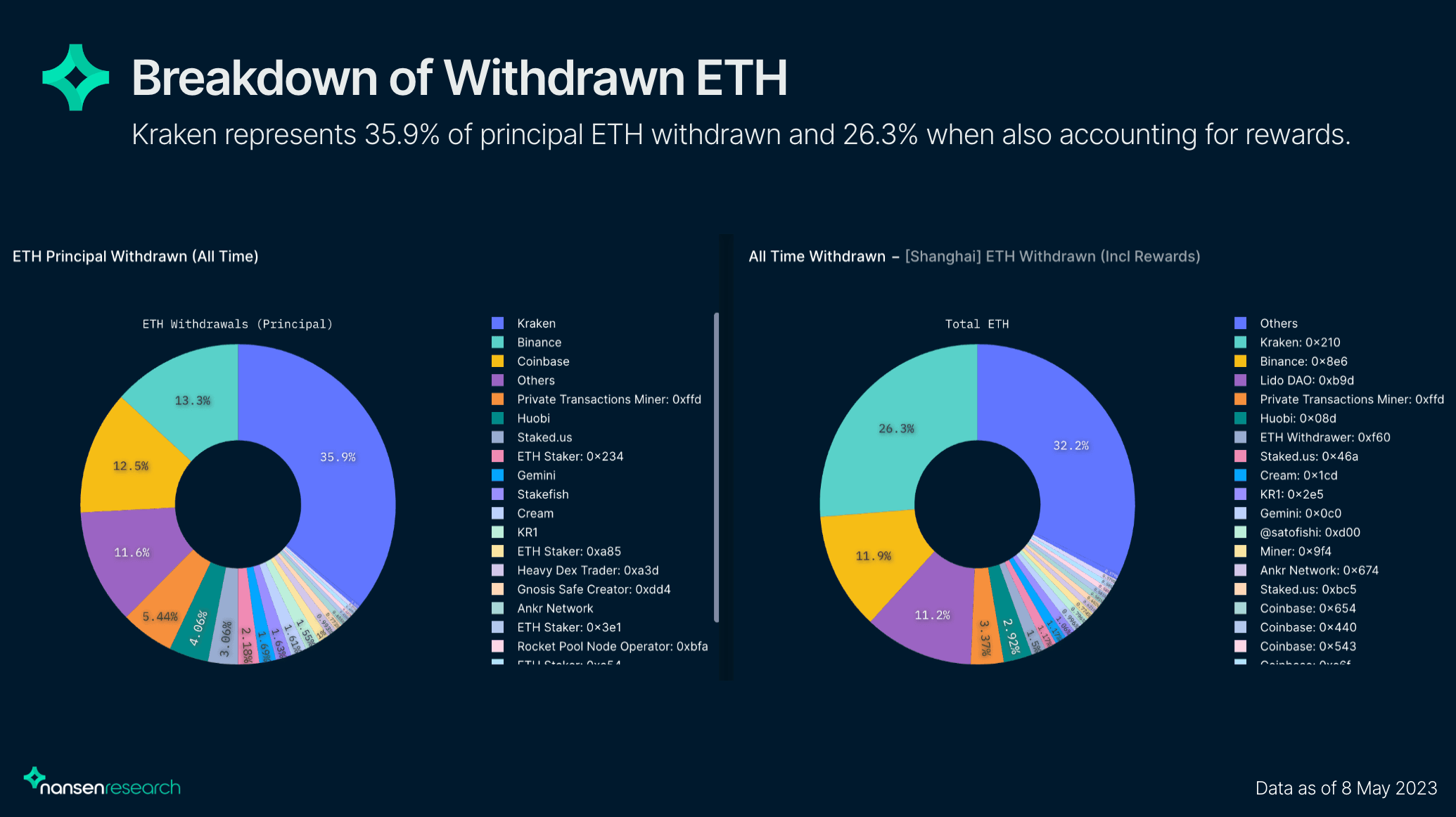
Kraken has contributed to 26.3% of all ETH withdrawn from the Beacon Chain. However, the proportion is much larger when only accounting for the principal amount withdrawn, with the exchange making up 35.9% of all the 1.44m principal ETH withdrawn to date. Other notable Principal ETH withdrawers include Binance, Coinbase, and Private Transactions Miner: 0xffd, with 13.3%, 12.5%, and 5.44% of the share of Principal ETH withdrawn, respectively.
Withdrawal Activity
Withdrawal Queue
The vast majority of ETH staked on the Beacon Chain (99.22%) are not scheduled to withdraw, while only 150k ETH (0.78%) are awaiting withdrawal in the queue from 4.5k different validators. The makeup of ETH withdrawers for different categories is as follows:

Most of the ETH in the withdrawal queue is from validators fully exiting their stake (Actively Exiting, Withdrawal Possible, and Exited Unslashed), some of which could be incoming selling pressure. On the other hand, the withdrawn ETH from exchanges like Kraken, who have contributed to a significant portion of full withdrawals, may not be sold as depositors may look to re-enter through DeFi or other staking solutions.
Current Withdrawal Waiting Time
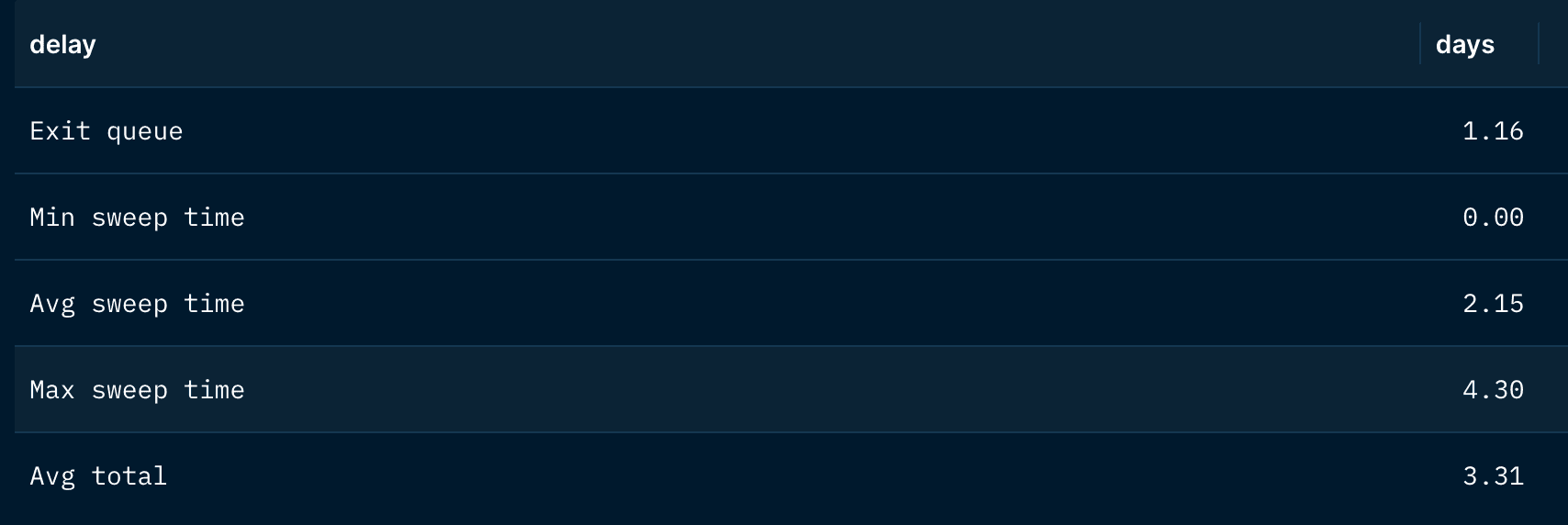
Partial Exit
As staking rewards are processed automatically with every validator sweep, eligible validators (those with 0x01 credentials) do not have to take any further actions.
A validator sweep is when a validator is scheduled to propose the next block. The validator is also tasked with building a withdrawal queue of up to 16 withdrawals. Assuming that there are no missed slots, there can be up to 115,200 withdrawals processed per day. Hence, with ~600k validators currently active, each validator sweep takes 4.3 days, at worst, and 2.15 days on average to complete.
Full Exit
On the other hand, validators who wish to exit their stake fully must submit a voluntary exit from the network, which has a 4-epoch delay (~25 minutes) before they are entered into the exit queue. With a current churn limit of 1,800 exits per day, the exit queue waiting period would take approximately 1.16 days, followed by a 256-epoch withdrawal delay (~27hr) before being eligible for withdrawal in the next validator sweep. Therefore, the average time to exit the principal amount with current network statistics would take roughly 3.31 days to complete.
Top Entities in the Withdrawal Queue
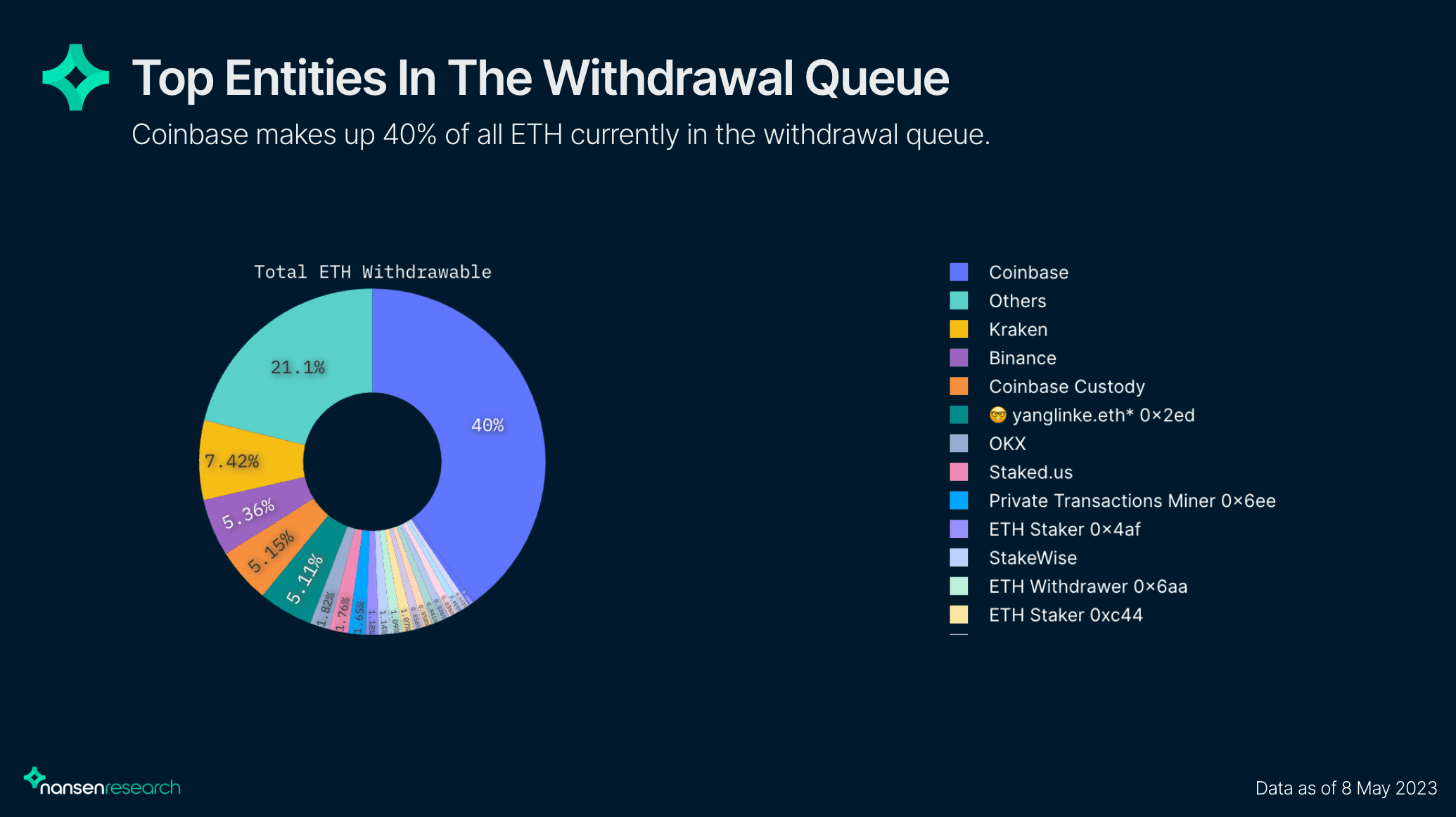
Coinbase represents 40% of all ETH currently in the withdrawal queue, followed by Kraken, Binance, and Coinbase Custody, with 7.42%, 5.36%, and 5.15% of the share, respectively.
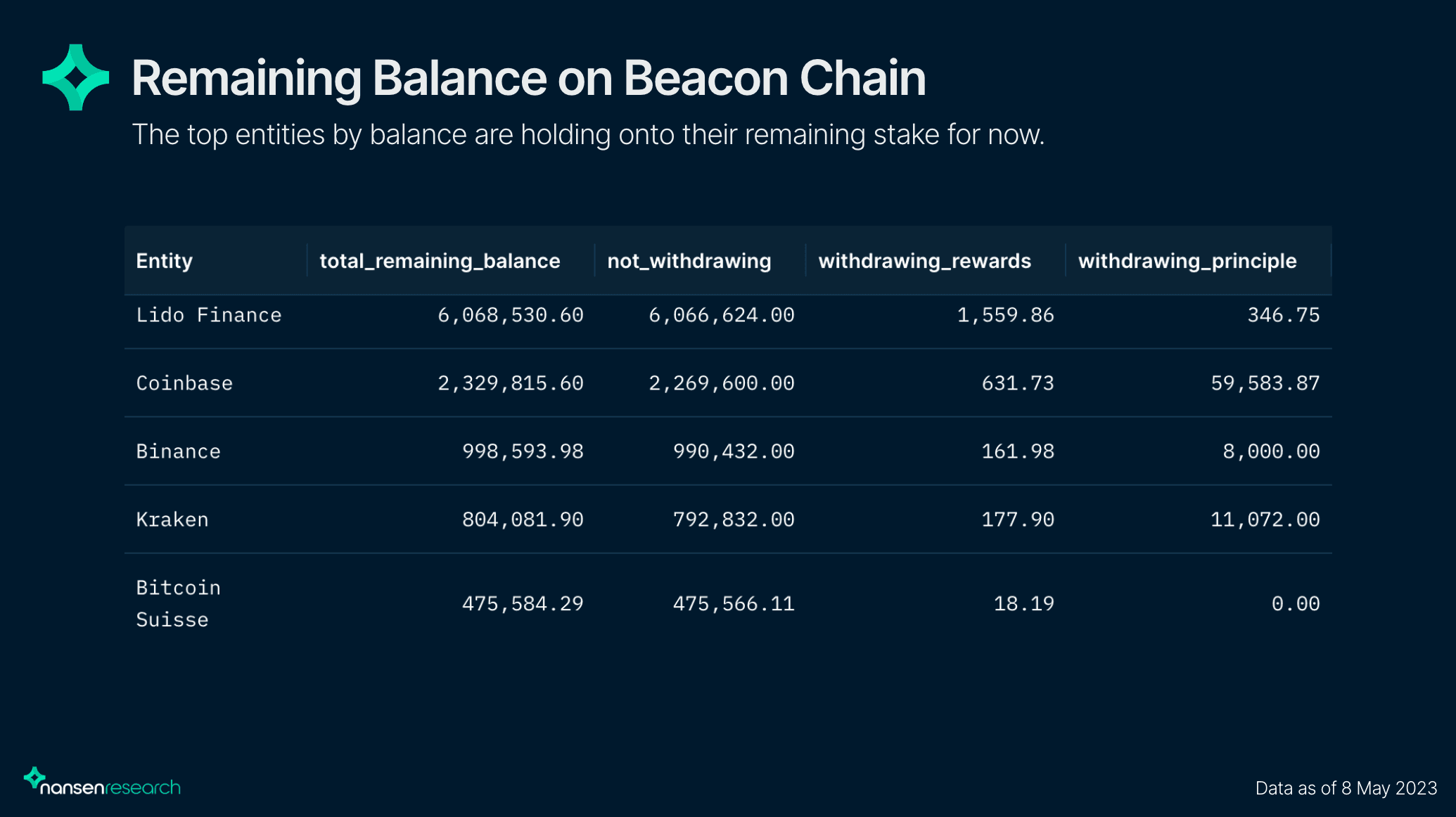
As seen by the table above, the majority of entities are currently holding onto their remaining balance for now. Lido remains the entity with the largest amount of staked ETH by some distance and is responsible for almost a third of all ETH staked on the Beacon Chain. Coinbase, the largest entity in the withdrawal queue, is withdrawing about 2.58% of their stack.
Top Depositors Since Shapella

The table above shows the leading depositing entities since Shapella. Unsurprisingly, the top entities comprise LSD projects and staking services, with Lido leading the way at almost 412k ETH in deposits. Lido’s staked ETH delta on the Beacon Chain since Shapella is positive. Lido has a lifetime withdrawal amount of 272k ETH compared to 412k ETH in deposits at the time of writing.
What Are Withdrawers Doing With Their ETH?
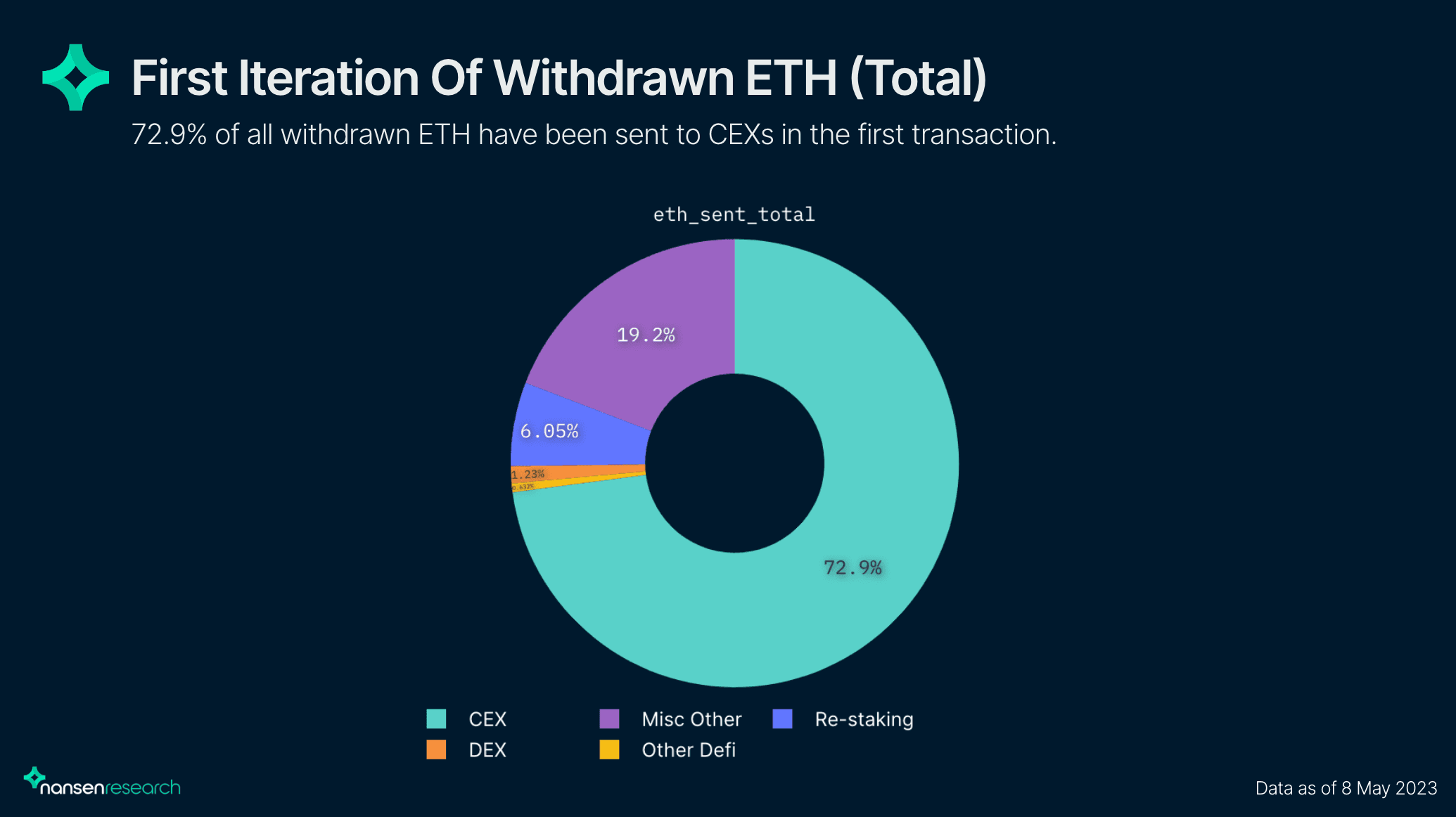
The chart above shows the breakdown of the first iteration of where the withdrawn ETH has been sent to, which gives an insight into what withdrawers are doing with their ETH as well as helps gauge some of the selling pressure from withdrawers in the immediate or shorter-term timeframe.
72.9% of the withdrawn ETH from the Beacon Chain thus far has been sent to CEXs. However, the majority of this is CEXs withdrawing ETH to themselves. This means that the majority ETH being sent to CEXs is not primarily for selling, but for the exchange's internal operations. In contrast, the amount of ETH sent to DEXs from withdrawers only represents 1.23% of the total proportion. 19.2% of the withdrawn ETH are classified as 'Misc Other', meaning that it was sent to all other types of addresses not labeled as CEX, DEX, Staking, or DeFi, according to Nansen, and approximately 6.05% of all withdrawn ETH was sent to re-stake.
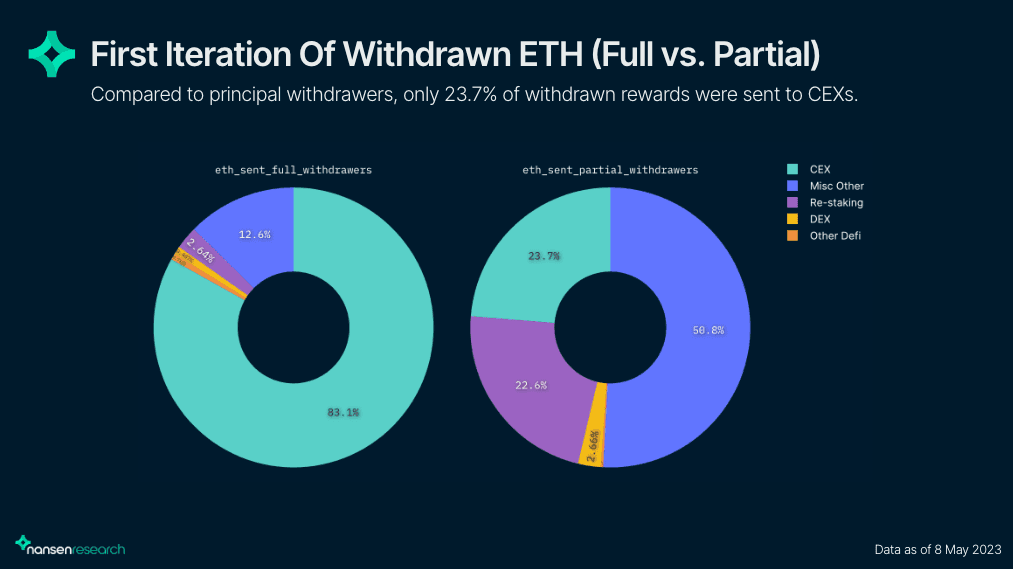
Although, separating the withdrawn ETH into full withdrawers (addresses that have withdrawn principal ETH) and partial withdrawers (addresses that have only withdrawn staking rewards) depicts vastly different pictures.
The vast majority of ETH from full exits (83.1%) were directly sent to CEXs. While 12.6% of ETH withdrawn from this cohort were sent to other miscellaneous addresses, only 2.64% were re-staked.
As for partial withdrawers, ETH sent to miscellaneous addresses represents the largest portion of the distribution at 50.8%, whereas CEXs and re-staking come in at 23.7% and 22.6%, respectively. This cohort is less likely to take profits (and are collectively less bearish) as they are still running validator nodes and staking rewards are processed automatically. Hence, some ETH from partial withdrawers would return to the Beacon Chain to earn more yield.
Things to Consider
While this analysis gives an idea of where the withdrawn ETH is flowing, the query only accounts for the "first hop" from the address withdrawing the ETH to the recipient address of that withdrawn ETH and only tracks the label of the recipient address. Hence, this could lead to some over and underestimations of different categories.
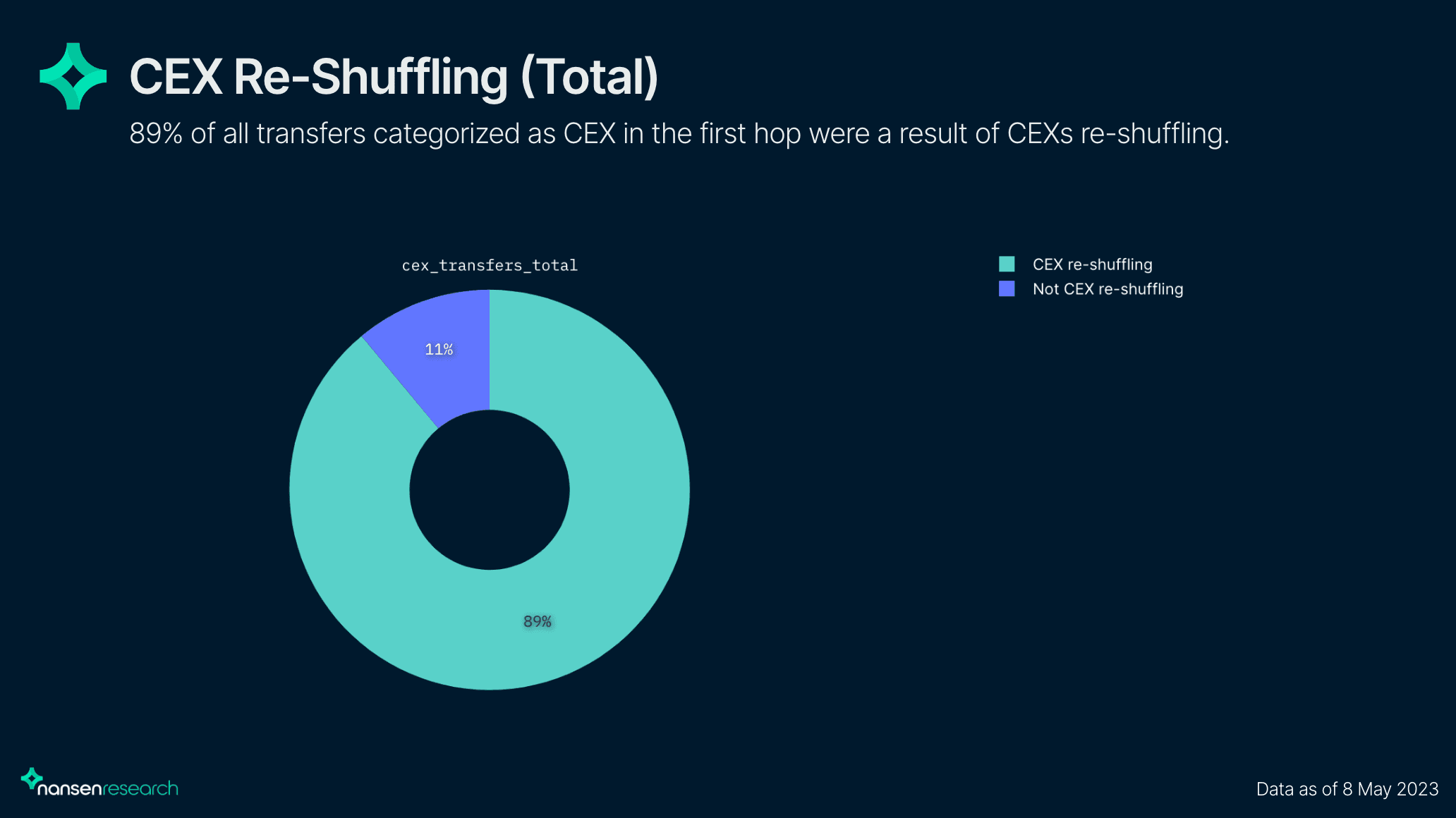
As the chart above highlights, 89% of all transfers categorized as CEX were CEXs re-shuffling among their wallets, which strengthens the claim that the majority of withdrawn ETH was not intended for selling. Thus, only 11% of the total CEX transfers can be regarded as potential selling pressure.

When breaking down into CEX transfers into full and partial withdrawers, the percentage of CEX transfers that were CEX re-shuffliing is much larger for full withdrawers than partial withdrawers. Specifically, 89.8% of the 83.1% of CEX transfers from full withdrawers were actually CEXs re-shuffling, compared to just 24.1% of the 23.7% of CEX transfers from partial withdrawers.
In contrast, staking may be underestimated. If Coinbase sends some of their ETH to another Coinbase wallet to re-stake, then the first hop would only classify this transaction as a CEX transfer rather than re-staking. Additionally, recipients of Kraken's staking service who re-stake would not appear here either since they would first have to transfer elsewhere.
Forecasting Daily Withdrawals
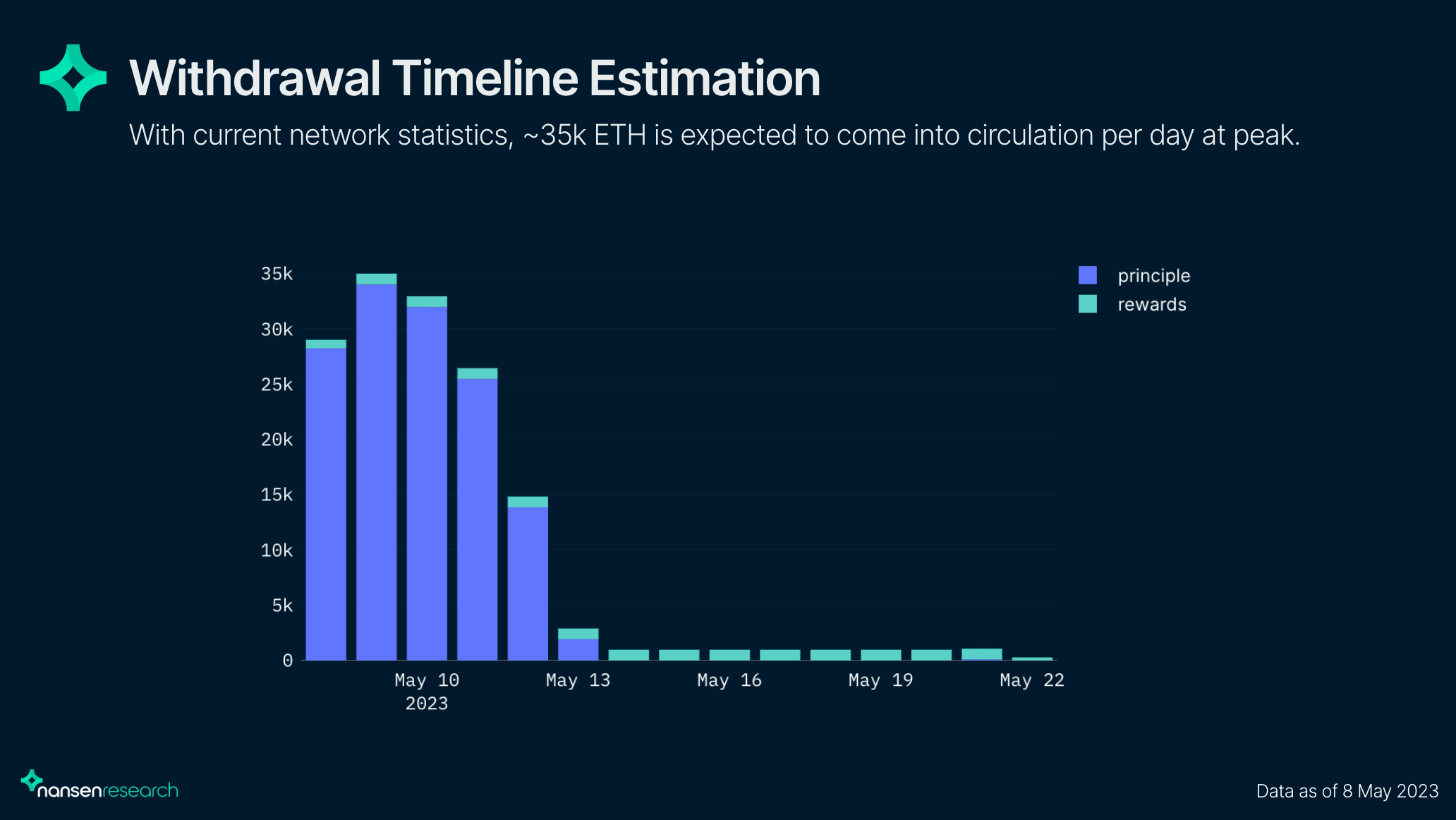
To forecast the selling pressure, our calculations for the daily estimation are as follows:
- Fully exiting validators (those with Active Exiting, Exited Unslahed, Exited Slashed, or Withdrawal Possible statuses) are validators who have either opted out of the network (initialized their exit), went through the 27hr withdrawal delay and waiting for the next sweep or are somewhere in between.
- The estimated withdrawal timestamp for each fully exiting validator is the individual withdrawable epoch timestamp (based on where they are in the process, taking the exit queue time into consideration)+ a random time interval to wait for the next sweep (randomized between 0 to current max sweep time to simulate the waiting time)
- This gives the estimated amount of principal ETH projected to be withdrawn per day based on current network statistics.
- The amount of staking rewards withdrawn per day is assumed to be constant. This is calculated by looking at the amount of current outstanding rewards and the number of epochs it takes to sweep all of it. We estimate average rewards swept per epoch and assume that this is a constant for the rewards payout.
- Combining the estimated amount of principal ETH withdrawn and the reward payout per day gives an approximation of the total ETH expected to leave the Beacon Chain daily.
Therefore, the distribution of withdrawn ETH per day is shown in the chart above. With the current network statistics, we can expect that there will be ~29k ETH going to Mainnet from the Beacon Chain today and peaking at ~35k ETH on May 9th before declining. This daily estimation can be used as an upper bound for the potential selling pressure in the short term. As evaluated in the prior section, not all the withdrawn ETH are instantly sold onto the market.
Note that for the current day, the estimated selling pressure will usually be less than the actual amount since this model shows future withdrawals. For example, if the current day is "15 hours old", then there will likely be less to withdraw for the rest of the day compared to the whole 24H for tomorrow.
Model Limitations
The current model only accounts for validators currently in the process of withdrawing rather than forecasting how many validators will exit in the future and only evaluates based on current on-chain statistics. Moreover, the model does not predict the number of ETH to be sold on a particular day, as withdrawers may not sell instantly but rather serve as an estimate for the amount of ETH withdrawn per day that could potentially be sold.
With the current network statistics, we can conclude that the selling pressure on ETH post-withdrawal has been somewhat of a non-event, supported by the fact that deposits have almost matched the amount of ETH coming into circulation. This means that the elimination of unstaking risks has thus far offset selling pressure from withdrawals. In addition, a substantial proportion of the ETH withdrawn is likely not intended for selling.
Furthermore, the vast majority of withdrawals have come from exchanges (~69.3%). This includes Kraken who is withdrawing due to an agreement with the SEC to cease its staking business (accounting for 26.3%). Other exchanges may be withdrawing due to previous non-liquid product offerings or simply to re-shuffle funds, with no obvious intent to sell. Ultimately, withdrawals have been minimal and have thus far been matched with inflows, signalling strong overall confidence from investors in the network and the asset itself.
Visit our public ETH Shapella Upgrade Dashboard here.




